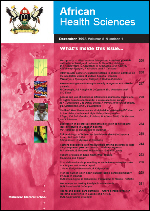
|
African Health Sciences
Makerere University Medical School
ISSN: 1680-6905
EISSN: 1680-6905
Vol. 21, No. 3, 2021, pp. 1141-1147
|
 Bioline Code: hs21074
Bioline Code: hs21074
Full paper language: English
Document type: Study
Document available free of charge
|
|
|
African Health Sciences, Vol. 21, No. 3, 2021, pp. 1141-1147
| en |
Assessment of hepatitis B surface antigen negative blood units for HBV DNA among replacement blood donors in a hospital based blood bank in Nigeria
Fasola, Foluke Atinuke; Fowotade, Adeola A & Faneye, Adedayo O
Abstract
Background: Hepatitis B virus infection is one of the greatest threats to blood safety all over the world. The laboratory
algorithm based on only the detection of hepatitis B surface antigen (HBsAg) leaves a gap for infected HBsAg negative
donors to donate blood during the “window period” (WP) and late stages of infection.
Objective: To estimate the frequency of the presence of HBV deoxyribonucleic acid (DNA) in HBsAg negative blood units
screened using two different assays for HBsAg in a high endemic region.
Methods: Frozen serum aliquot of 100 replacement blood donors who donated blood units that were HBsAg negative
were retrieved and tested for HBV DNA. Sample positive for HBV DNA was sequenced by Sanger’s method, genotyped
and the viral load was determined.
Results: One sample (1%) was positive for HBV DNA. The HBV viral load of the sample was 768,000 IU/ml. The partial
S-gene of the Hepatitis B virus isolated was genotype E using the NCBI viral genotyping tool.
Conclusions: There is still a risk of HBV infected blood unit escaping detection when donor testing is limited to HBsAg
screening. The use of NAT which can substantially reduce HBV infected blood donors from the donor pool should be
considered.
Keywords
Hepatitis B surface Antigen; Hepatitis B Virus; DNA; blood donors; blood safety.
|
| |
© Copyright 2021 - Fasola FA et al.
|
|
